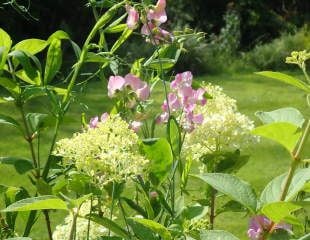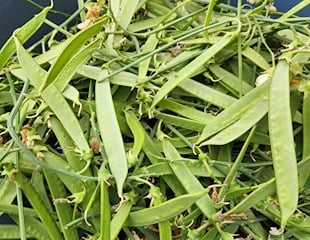

How to Grow The Everlasting Pea
Key Facts:
Height: up to around 2m
Light: best in full sun
Soil: tolerant of all soils (except boggy)
Special Features: Everlasting pea is a tall, summer-flowering perennial that produces masses of flowers for several weeks. It is easy to grow, a vigorous climber which will self-seed.
The Everlasting Sweet Pea, Lathyrus latifolius, looks very similar to the annual sweet pea, Lathyrus odoratus. The Latin name "odoratus" highlights the essential difference between the two varieties. Annual sweet peas are usually scented; everlasting peas are not.
There are about 20 varieties of everlasting Pea seed available to buy. There is one variety available to grow from seed called Lathyrus nervosus, Lord Anson's Blue Pea, which has a discernible sweet pea scent. It is a vigorous climbing plant, with blue/lavender coloured scented flowers.
The Everlasting Pea is an attractive shrubby climber, easy to grow from seed with many delicate flowers, usually in soft pastel shades, blues and purples. There is also a pure white variety called "White Pearl". Many climbing plants are more difficult/time-consuming, such as Clematis, or Wisteria. The Everlasting Pea is refreshingly easy to grow.
The Everlasting Sweet Pea is easy to raise from seed and Suttons have a lovely collection seed mix.
Growing The Everlasting Pea from seed.
Plant Everlasting Pea in full sun, although it is tolerant of some light shade. Growth is similar to that of the annual sweet pea, clinging on with tendrils climbing or scrambling over an obelisk, trellis or adjacent shrubs. Unlike the annual pea, the everlasting pea is very hardy, H7, which means it will survive the most severe of winters.
It is not particular about the soil type, acidic or alkaline, clay, etc, although it will grow best in fertile soil with plenty of moisture. Ensuring it has plenty of moisture will help to fend off powdery mildew.
Except for cutting back the Pea in the autumn, the growing conditions for the annual and Everlasting Pea are very similar.
The tendrils can be a problem as they will grab adjacent plants and can swamp them. This video about removing tendrils from sweet peas applies equally to the everlasting pea, if you want to keep its growth upright. I do not find it necessary to feed or grow in particularly rich soil. It is best cut back in the autumn to ground level. I find the everlasting pea quite vigorous, and takes over a bit and swamps adjacent plants. During the summer, I remove tendrils and cut it back a bit to keep it under control.
There is also a variety called Lathyrus grandiflorus. Warning, it is very vigorous, bordering on invasive, and I would personally avoid. L. latifolius is better behaved.
Growing The Everlasting Pea from seed.
To germinate the everlasting pea, follow the same method as for annual peas, but always sow them in the Spring. Sow anytime between Feb and March, in seed trays or small containers using a peat free compost. Keep in a warm place around 18C to germinate, which will take around 10 days.
Pot on when large enough to handle and then move outside to gradually harden off, ready for planting out. The everlasting pea is easy to germinate and a hardy perennial.
Should I dead head Everlasting Pea?

There are two good reasons to deadhead everlasting peas.
Firstly, particularly early in the season, this will help to prolong flowering.
Secondly, Everlasting Peas produce a lot of seed, as per the image, and they self seed. You may feel that you have enough Everlasting peas in the garden, in which case it's important to deadhead to prevent the seed from spreading.
